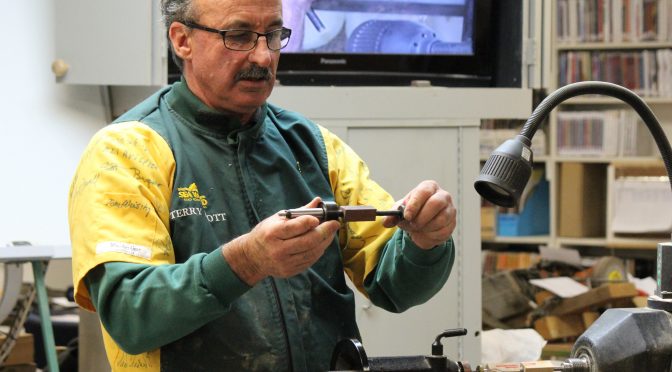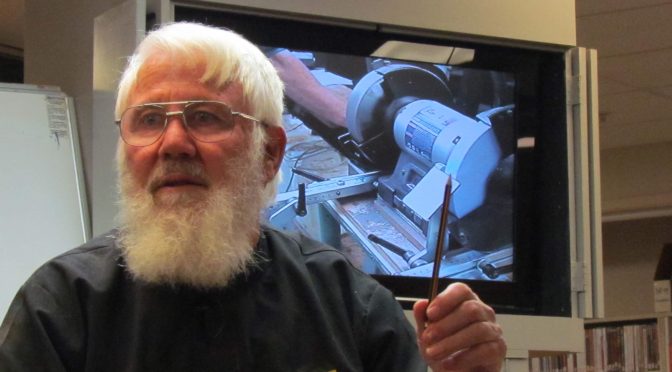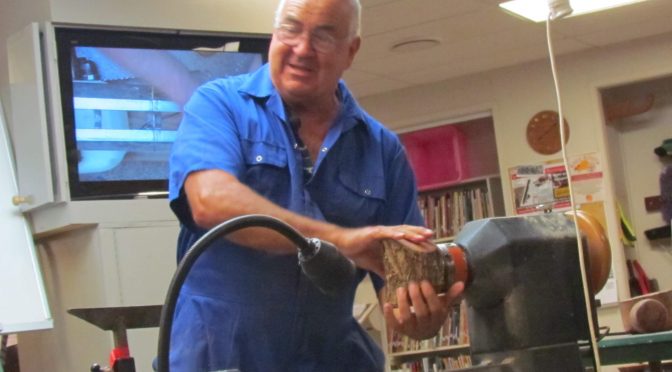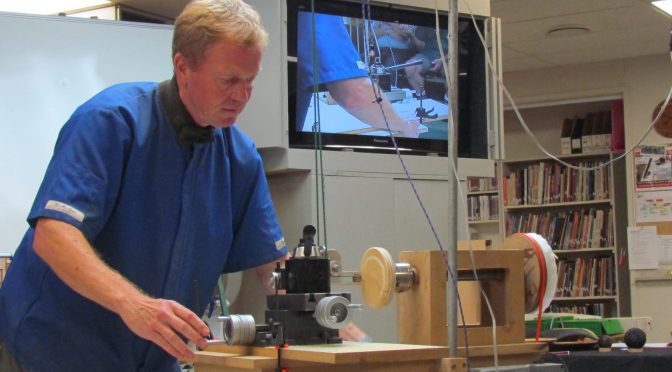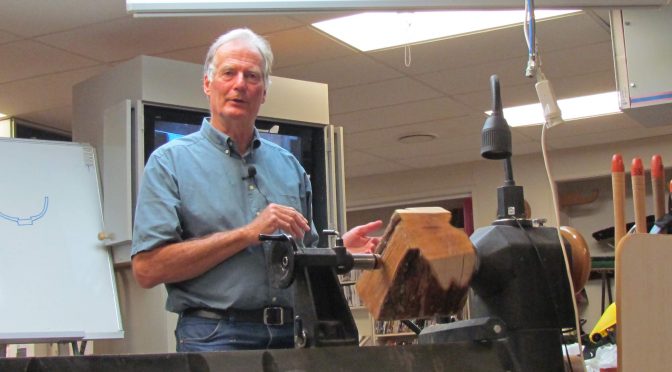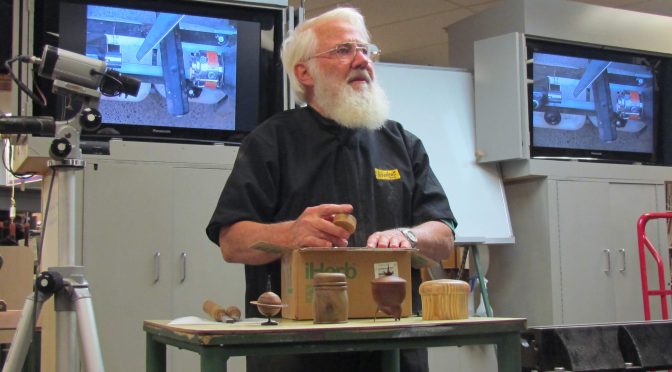All posts by Webmaster
Show & Tell 2019-05-01
Terry Scott – Pens
So the plan was to have a hands on night, where each member of the club made a slimline pen.
As there have been many new members since the last attempt at something similar, Terry started with a “short” demo. Of course Terry the proceeded to try and get everything he could about how to make a pen into the demo, here is a quick report of the major points.
Blank – 20mm square cut slightly longer than tubes
Mark to keep grain aligned
Drill a 7mm hole for the tube – alternative methods of drill press with jig or on lathe using pin or pen jaws were discussed
With lathe option about 500rpm. Make sure you align the lathe head first.
Rough up the outside of the brass tube with some sandpaper
Put potato plug in end of the tube to prevent glue going in.
Glue into blank with superglue
Mill ends of blank – don’t use vice as may stretch brass tube.
Put the blanks on a pen mandrel with bushes to match pen kit.
Mandrel saver (live centre) presented as an option instead of default knurled nut.
Turn lathe up fast as you are turning a very small diameter.
Cut from the centre out with spindle roughing gouge.
Skew for finishing cuts
Sand through grits -240 320 400
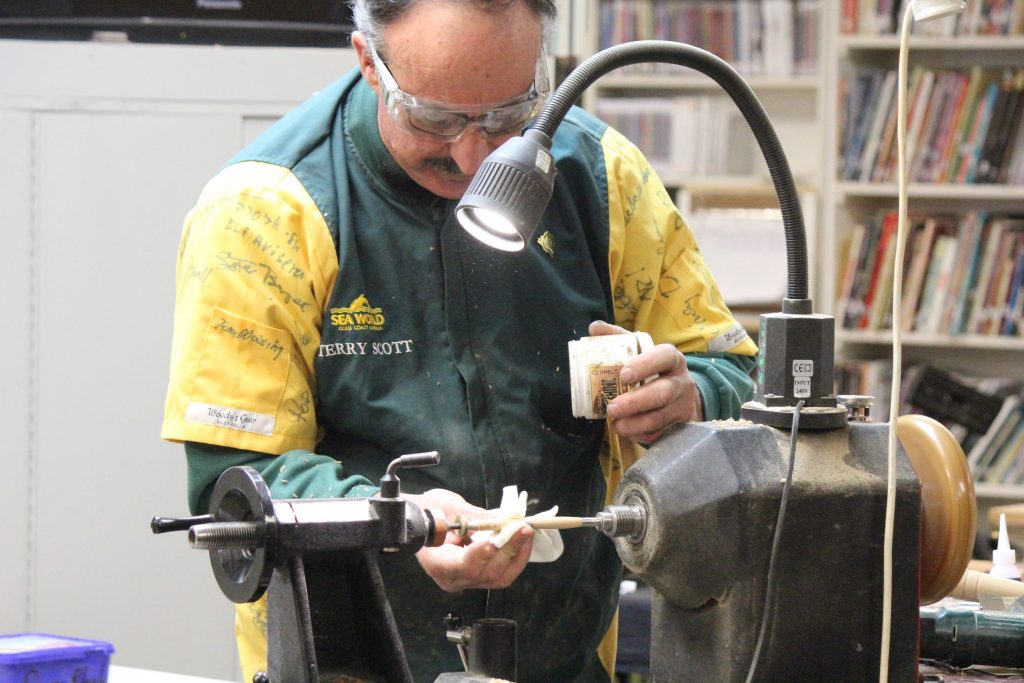
Use U-Beaut EEE-ULTRA SHINE to get a high polish.
Terry the used SHELLAWAX GLOW to finish.
Take the matching pair you have just turned – keeping the grain aligned. Terry suggested if turning a lot of pens to make up a board with 4 inch nails to keep them together.
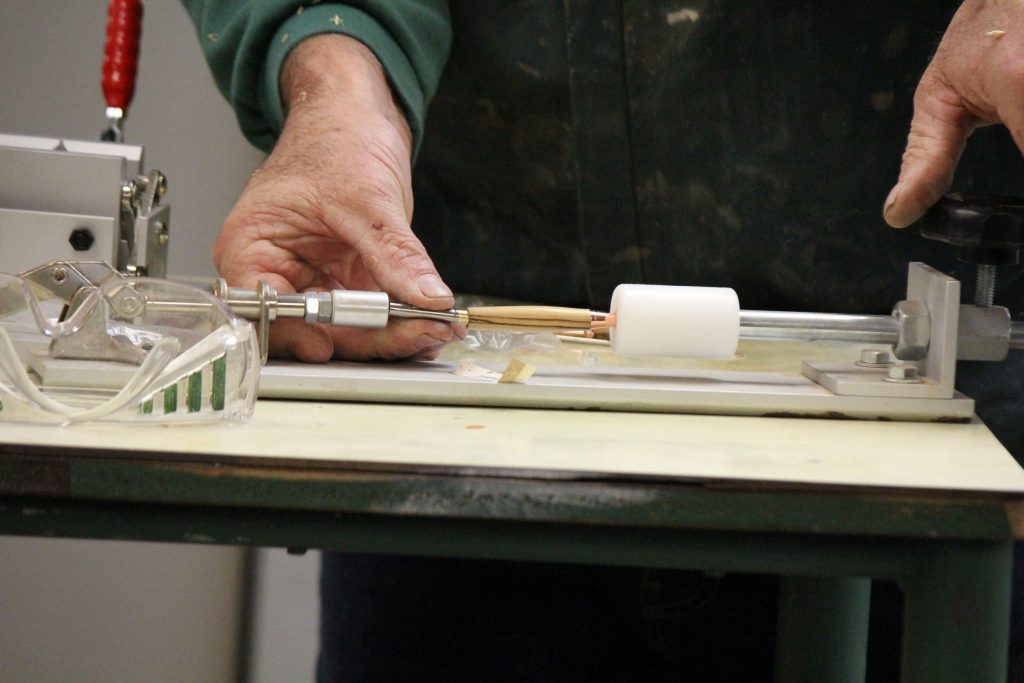
Assemble pen – taking care to put mechanism in correct distance into the pen to have the point protrude the correct distance and allow it to retract.
Terry then gave a quick demo of the disassembly process if you want to refinish a warn pen or replace some parts.
The crowd then went to the lathes and the real fun began. Many people taking home a successful first pen.
Thanks Terry.
Dick Veitch – Sharpening
Club Meeting: 8 May 2019
Report By: John Whitmore
The intention was to both inform members and to preserve the Guild’s tools. Consistent sharpening of SAWG tools makes it easier for new turners to move between work stations and the tools last longer. Instruction is available for using the sharpening station.
Tools can be sharpened on either an abrasive wheel or on a flat abrasive surface such as a disc or linisher (a belt sander in disguise). Whilst all have their merits, the basic difference is that wheels produce a concave bevel and discs/linishers give a flat bevel. Honing was not part of this presentation but could usefully be incorporated in a later demonstration.
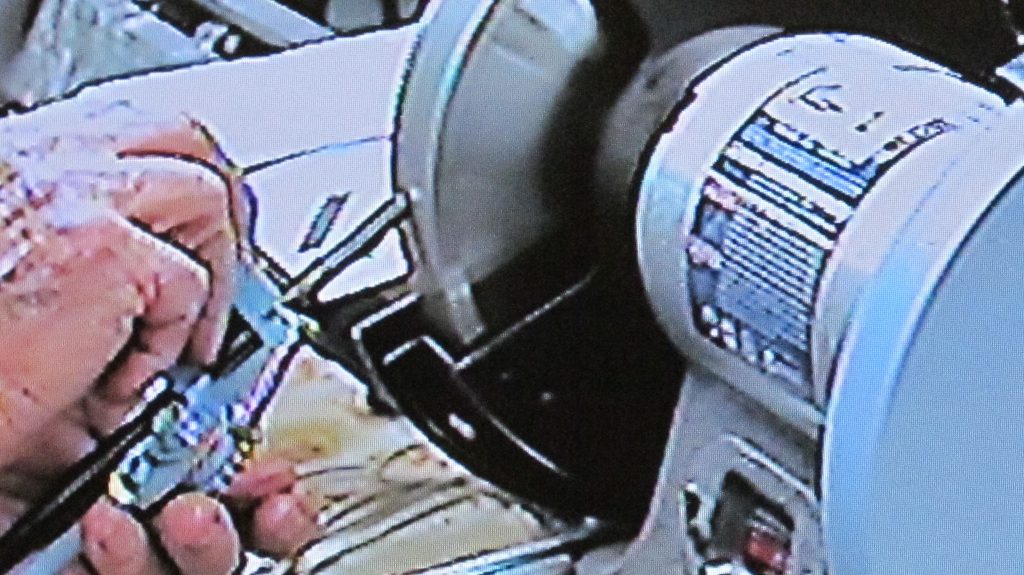
The usual form of abrasive wheel sharpening is via a double-ended grinder having wheels of 150mm (6”) or 200mm (8”) diameter, the larger size being preferable but more expensive. More specialised machines are available including several brands with larger 250mm (10”) wheels running in a water bath and slower speed grinders intended to reduce the generation of heat.
Ordinary ‘workshop’ grinders are usually supplied with (grey) carborundum wheels of low quality. Internationally, there is a variety of different coloured grinding wheels purporting to serve different purposes but the ideal approach is to have a cubic boron nitride (CBN) wheel for high speed steel (HSS) tools at one end, plus an aluminium oxide wheel (white) for other ferrous materials, at the other end. Both are readily available in NZ.
The use of a 300mm disc sander for sharpening was developed in-house and with a jig for each tool, enables a quick ‘polish’ rather than serious grinding to replenish an edge. The linisher is a much more expensive product by Robert Sorby having a useful variety of easily interchangeable belts and reliable jig settings for repeatability. Whereas all grinding wheels (except the CBN) gradually reduce in diameter, the disc and belt abrasive surfaces remain consistently flat.
Other useful points arising were:
- Recommended bevel angles for Guild tools are bowl gouges of 35 and 55 degrees, spindle gouges 30, spindle roughing gouges 45, parting chisels 30, skew chisels 30.
- Wheels, disc and linisher abrasives have different grits (or roughness) and hardness.
- Don’t dip HSS tools in cooling water as the temper will be ruined. Tool steel is OK for cooling.
- Always use a jig to achieve a single, smooth, and symmetrical bevel. This doesn’t work well for negative rake scrapers or if an asymmetrical bevel is wanted – the latter usually by professionals freehand sharpening.
- Putting a diamond-section parting tool sideways into the Guild’s Truegrind tool holder enables both bevels to be sharpened without any repositioning.
- A diamond dresser is available for cleaning dirt and glaze off all sintered (cooked in an oven) wheels. A CBN wheel is never dressed.
- Sintered wheels can shatter so always use them with guards in place.
- Do not sharpen on the side of a wheel unless specifically labelled as a side-cutting wheel.
- A 55 degree bowl gouge is useful across the inside bottom of bowls when a more ‘pointy’ 35 degree grind may result in a gouge shaft hitting the bowl rim.
- Sharpening a pencil is a good analogy to explain ‘cutting with the grain’.
- A plug was also given for using sharp sandpaper.
Alongside the theory, sharpening using Guild jigs and tools was demonstrated with some bowl shaping. The presentation was accompanied by excellent visual aids and invasive music from next door. Despite the music, a good time was had by all and clear information was received during a well-structured performance.
Peter Williams – From Log to Bowl
1st May 2019
Report by: Judith Langley
This was a brilliant presentation from a very well recognised woodturner. Peter had travelled down from Kerikeri and met up with his old colleague Ian Fish to present to the South Auckland Woodturners Guild. The many members in attendance must surely have reflected on a great deal of the experiences and words of caution outlined by Peter in their own woodturning ventures. Peter opened his presentation by sharing his own introduction to woodturning and was once a member of our Guild.
The most problem once you start to turn wood it that it is:
- Addictive
- Exciting
- Competative
- Interactive
- and introduces friends for life.
Wood
Where do you find it?
A Chainsaw really makes life easy, but it’s a dangerous tool.
Aspects of Safety where discussed – a wonderful log support frame was on display for members, this would handle most log sizes used by members. A couple of fence battens and a half round post cut in half is all that was needed to build this jig. A must have.
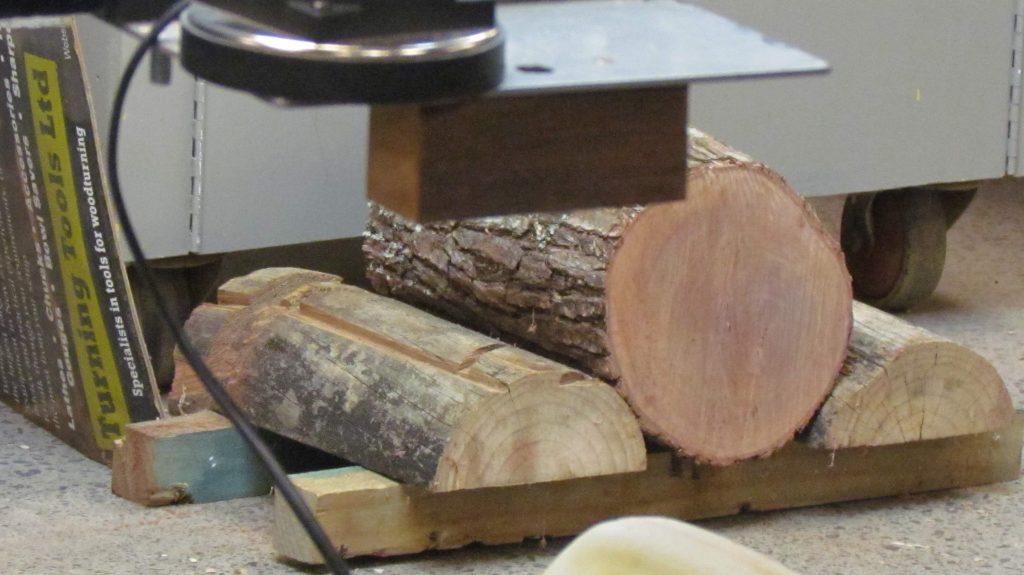
The chainsaw settings: Teeth at 30 degrees for cross cut, and along grain cutting.
Teeth need to be set at 90 degrees for end grain.
Obviously a selection of chains would be required to accommodate both methods of cutting.
Peter produced his favourite Makita electric chainsaw, noting that his wish list was for a battery powered model. Bantering from Dick Veitch on the pros and cons of battery powered saws, suggesting that Peter should settle for nothing less than the latest Stihl.
Green or dry timber?
There’s an unlimited supply of green wood. The size of bowls is not limited by standard stock sizes available from a wood yard, but only limited by the time available to go wood hunting. Collecting is exciting as you never know what you will find. Turning green wood is easier than dry. Pururi or gum is a nightmare to turn dry.
Transporting: You need to cut your bounty into manageable sizes. Probably 4ft lengths will fit across most trailers, without too much effort in loading. A great explanation and diagram showed members how to load large logs onto a trailer. The system was based on leverage with a long rope fixed at the front of the trailer and trailed to the back, slid underneath the log and back around the tow bar. Two 4×2 boards were used as a ramp. The rope was then attached to another vehicle which pulled very slowly while the log was rolled up onto the trailer deck. A very descriptive explanation of the trip home had members in awe of such a successful wood hunt. We were reminded to seal the ends of the logs to control moisture loss. Peter’s theory of cutting 4 foot long logs was that there was usually some good non split wood in the middle.
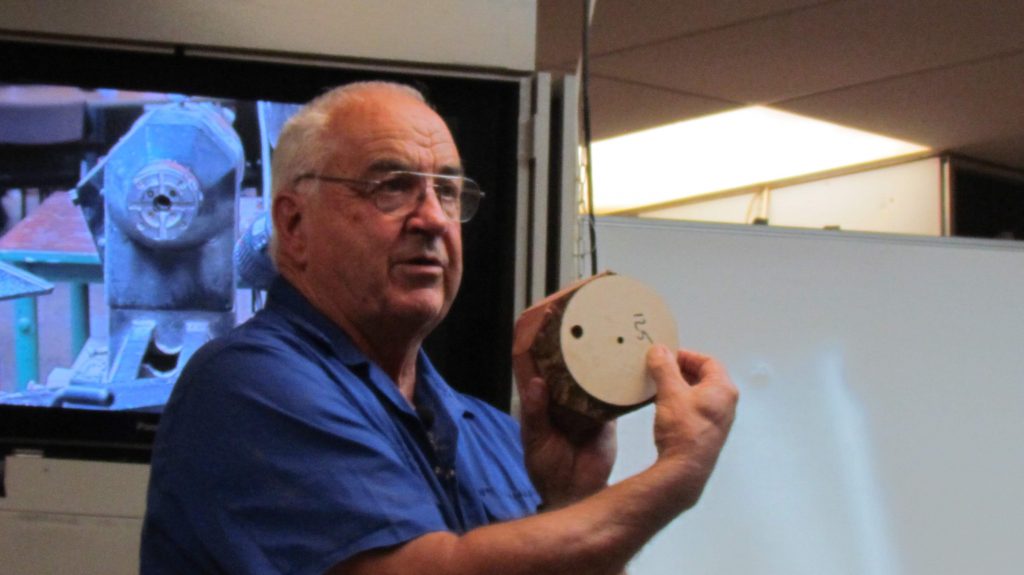
How to form the blank: Depending on log size, this will dictate on whether the log is just split or slabbed.
It’s easier to start off with a basically round shape before you put it on the lathe. Peter demonstrated the safe way of holding and cutting wood on the band saw, and the importance of stability of the log being cut. Peter explained that he always used disk templates from 125mm to 400mm in diameter. A blank that had been cut to a handy template size was tabled as an exhibit, along with the waste wood.
A thin disk of wood was presented showing where to take various bowl blanks from in order to avoid the pith. The pith is the soft centre of the log. After all it’s the pith that pithes you off!!
The easiest bowls to cut are from side grain. Green timber is usually sought for making bowl blanks.
Points to remember were
- Turn as soon as you can after collecting the wood.
- Seal inside and out with a wax rich medium as soon as the bowl blank is formed.
- Record the date, species, collection location and most importantly the weight.
- Store the blanks stacked somewhere cool and out of the sun to allow for slow even drying. Every 2 to 3 months reweigh and record as the blank loses moisture. Once the weight no longer reduces the blank is dry enough to finish.
- Sometimes a moisture meter is used in conjunction with weighing.
- Drying can be accelerated using a kiln or a closed box with a dehumidifier for finishing later when dry enough.
- Could be wrapped in 1 sheet of newspaper.
- Dry timber can be mounted straight on the lathe and worked to a finished bowl.
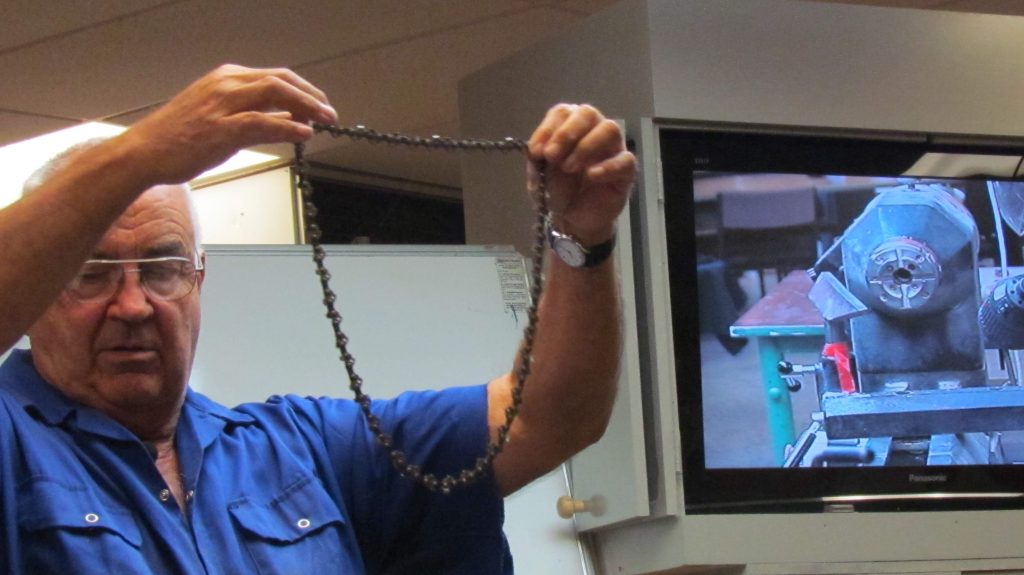
Considerations>Bowl shape: Peter explained the Catenary curve – using a string of beads or a light chain he demonstrated the various curves than can be created – curves that were pleasing to the eye!
However, it was important to establish designs and features that defined the turner and ultimately created work that is unique. There always had to be a connection between the bowl and the foot, and this aspect could not be ignored. The foot should always be in balance with the piece.
Ready to make your bowl
How to use a gouge – Your tools must be sharp.
Theories on gouge sharpening, bevel angles, jigs to assist with maintaining the correct angles, along with an overview of the wide variety of gouge bevels used nationwide. Northland use a 55degree bowl gouge with swept back wings at 35degrees, whereas South Auckland mainly prefer the 35 degree gouge for general turning and a 55 degree gouge for refining the inside of bowls. Preference is something that comes with experience.
RUB THE BEVEL:
The same old same old !! rub the bevel!!!
Once the gouge is sharpened it can be used for any one of four things.
- Push
- Pull
- Tilt
- Twist
When using gouges and doing the push and pull cuts, most catches come from allowing the gouge to cut while not being supported by the bevel. Without bevel support, the cut will dig in violently in a split second. Big chunks of wood are ripped away. The bevel prevents the gouge from cutting too aggressively—it is a controlling factor. Peter guided the gouge tip with his thumb when entering a starting cut on the inside of a bowl.
Attaching the wood to the lathe: another moment of interjection – this time from Bruce Wood who was determined to show Pete his method of fitting the screw chuck in the Nova chuck. However persistent Bruce was, Pete reverted to his presentation plan. This was a period of light hearted banter and laughter.
The faceplate was the preferred option for most mounting over 150mm.
Grain – an excellent example of grain direction and the cutting process was presented with the following diagram being most helpful to newer members
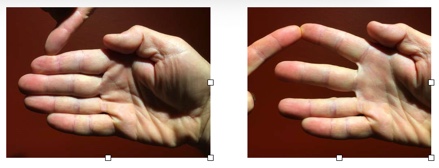
Turning:
Mounting the round– bring up the tail stock whenever possible.
Form the outside of the bowl first
Let the grain govern the direction of the cut.
Feet positioning: Place your left foot first in the finishing position then the right foot at the start of the cut.
Swing from the hips, which is not so easy when on the inside of the bowl.
Roughing: start from the tailstock centre and work the shape. Can use either a push cut or a pull cut.
Always rub (kiss) the bevel using a push cut. This steadies the gouge. Because you are pushing the tools and it wants to buckle, it can’t so it either digs in or scoots away.
Finishing a bowl blank after it has been dried:
The blank will probably be out of round after drying. So mount the bowl so that the chuck bite can be trued up by positioning the foot towards the tailstock.
There are a number of ways you can hold the bowl in this position. Cole Jaws chucks are easy to use, but keep the speed down and bring up the tail stock before starting the lathe. Similarly, if you are using a vacuum chuck, check for cracks in the wood, anywhere air can escape or OUCH – your bowl takes off into orbit. It is important to see that the bowl is seated properly too. If you don’t have access to this equipment, use a compression chuck. You can make one yourself – a simple rounded jig not unlike a darning mushroom, costs nothing and is very useful. Use a piece of thin rubberised matting (probably a bit in the cutlery drawer) over the compression chuck and fit carefully into the bowl. Centre with your tail stock (having marked the spot during roughing out).
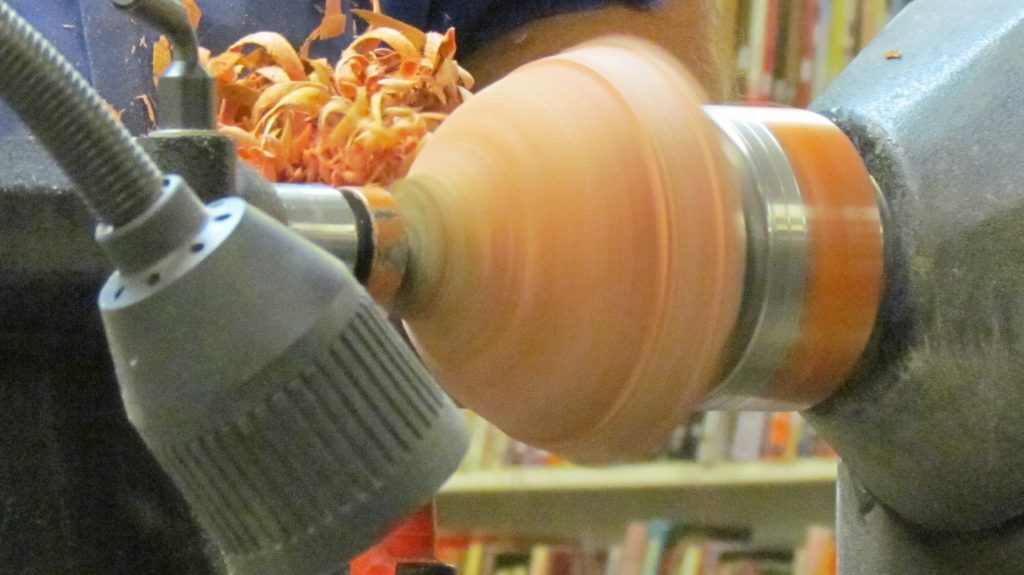
Remount the blank and turn to finished shape. Starting with the chuck bite, make cuts slowly and shape the outside. Finish the outside first then reverse the bowl, hold in the chuck, and finish the outside. You may have to retouch the outside near the rim of the bowl to get an even thickness of the rim.
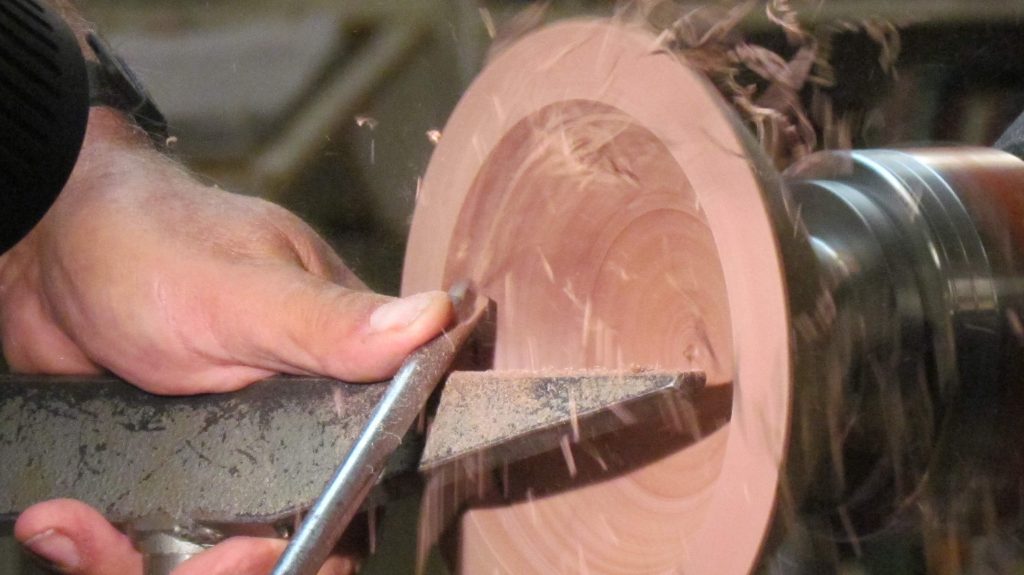
Once the bowl is turned to your satisfaction, sand through all the grits using a power sanding system. This will leave you with an amazing surface. Now it’s time to apply the finish and see your creation come to life.
Peter was very particular with his sealing and waxing, leaving the product to dry before wiping the excess off and rubbing the compound into the grain. Peter used toilet paper as his preferred application material.
Other clothes were not recommended because they left lint which often caught on the cut grain.
This was an excellent presentation by a world class wood turner, and we as a club are very privileged
to have shared in Peter’s life-long learning experiences.
Having written this review, I must thank Peter for sending me his notes, because the majority of this report is taken from the raw material provided.
Important – Don’t forget to have a cuppa at and during each stage!!
Holm Miehlbradt – Rose Engine
Date: 27th March 2019
Report by: Bruce Wiseman
An ingenious piece of mechanism individually made by Holm Miehlbradt.
TOTAL STORY !! — You had to be here to understand what was being demonstrated.
See if you can work it out from the photos taken by Ross Johnson.
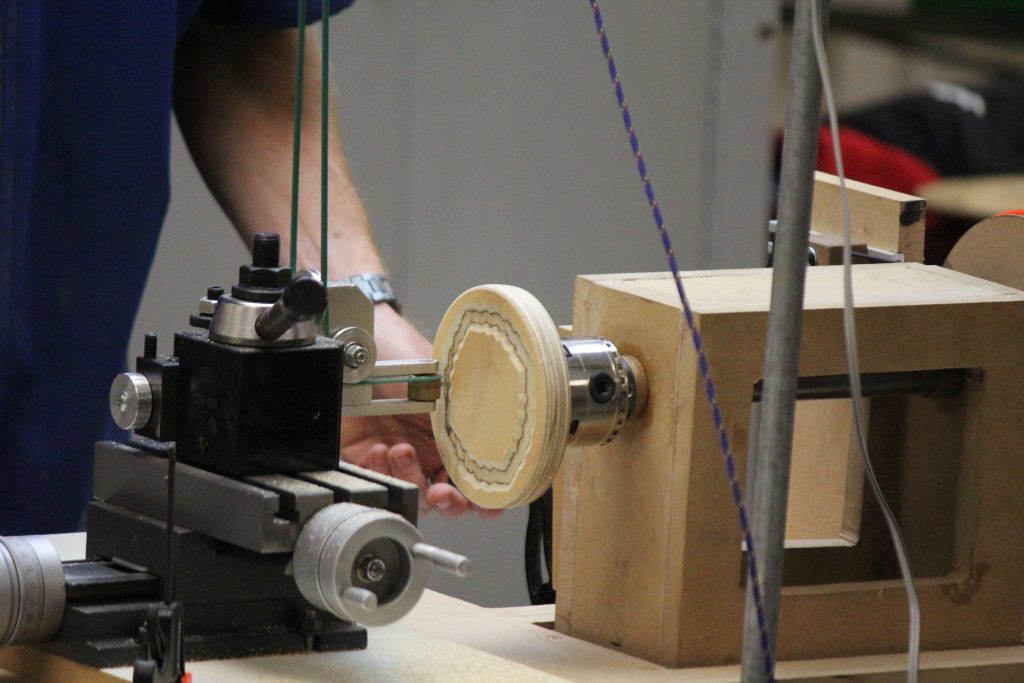
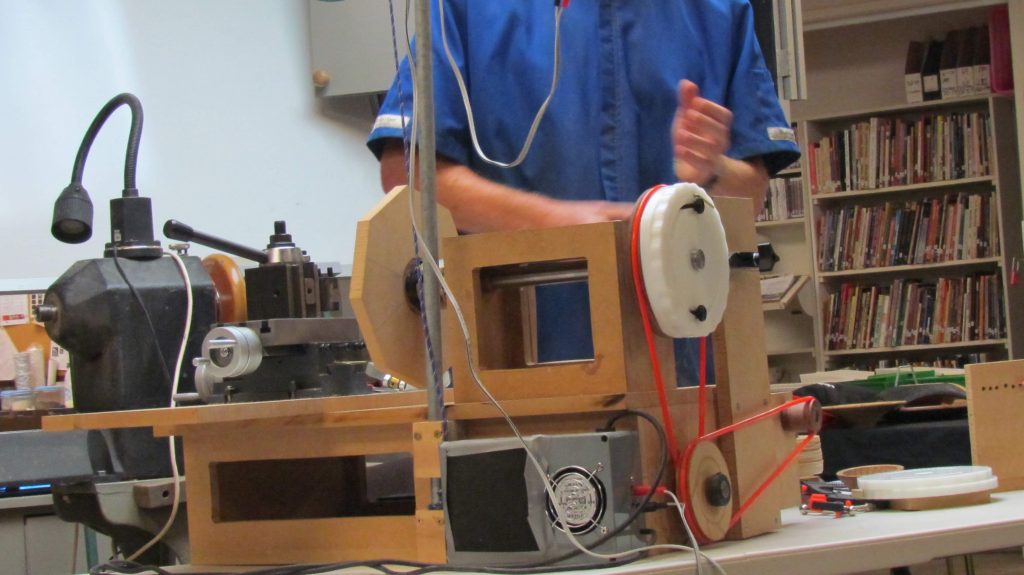
This was an unexpected demonstration of an engineer’s determination to make a complicated piece of design concept to produce a machine that will produce repetitive patterns of a circular character on wood, plastic, or other similar substances.
Holm using MDF for the main frame and lathe head, a compound slide to carry the tool holder and cutter head, together with a powerful electric spindle motor and sundry pulleys, sheaves and rubber band type drive belts created this amazing piece of wizardry known as a Rose Engine.
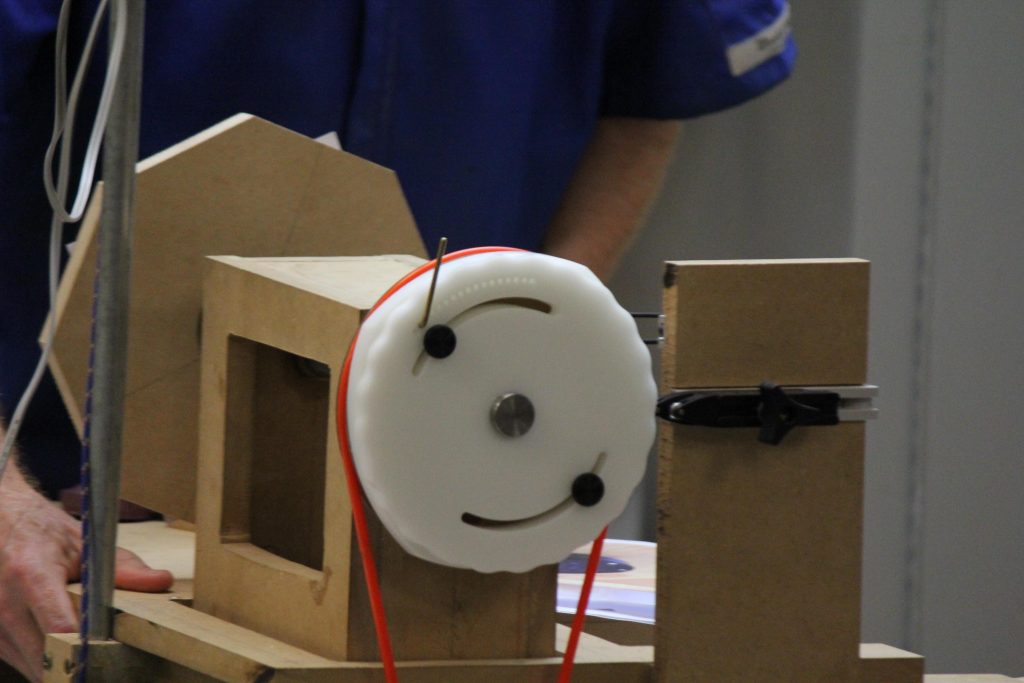
With the lathe head rocking back and forward to the pattern of the Rosette pattern and the cutter driven by the spindle motor, all controlled by a pair of hand wheels, the product was produced.
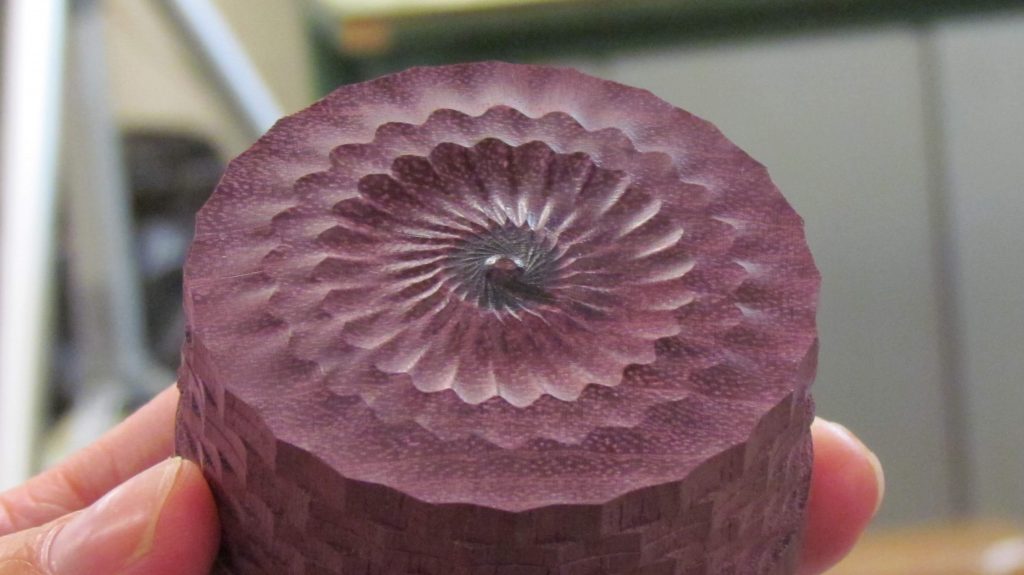
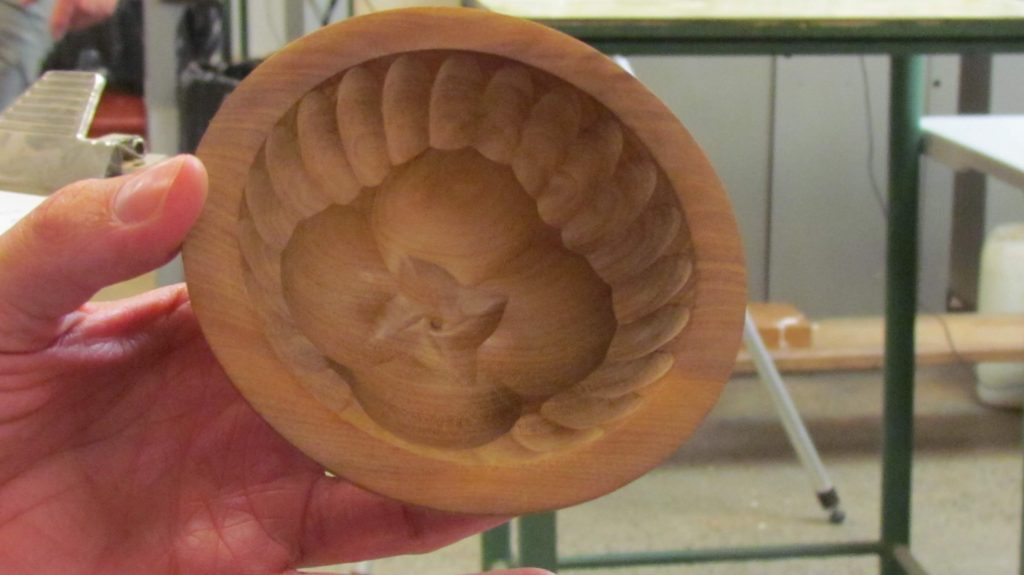
Comment:- You need to have a lot of time to make and use a ROSE ENGINE.
Well done Holm!
Additional link for more information on how to build a rose engine http://www.whidbeyworks.com/root/Home.html
John Whitmore – Rough as Guts
Date: 10th April 2019
Report Author: Emma James-Ries
This demonstration by John was complimentary to Richard Johnstons’ demo on wet turning earlier this year. John started by giving us an over view of why one might want to turn wet wood and the different qualities it possesses.
Some positive reasons to wet turn: For Woodturners it can be a feast or famine situation when it comes to acquiring timber and we’re more likely to be offered green wood. Wet wood gives the opportunity to turn very thin work, allowing it to distort and create interesting shapes. Green wood often come with the bark still attached, granting occasion for a natural edge bowl. Additionally cutting of wet wood creates very little dust, it is easier on your tools and creates very little dust. Drying of a green cut bowl will only take a year to dry, as opposed to a raw lump needing several years to properly dry. John reminded us of the very important point of striving for domestic bliss, as turned wet wood creates less storage and clutter within the household.
Some negatives to recognise would be that some timber can distort badly, particularly fruit trees. John told us of an incredible situation where a turned wet bowl of apricot had completely turned inside out whilst drying! Other points would be the possibility of wood going mouldy and to always be aware of irritant or toxic sap when turning wet, best to keep forearms covered.
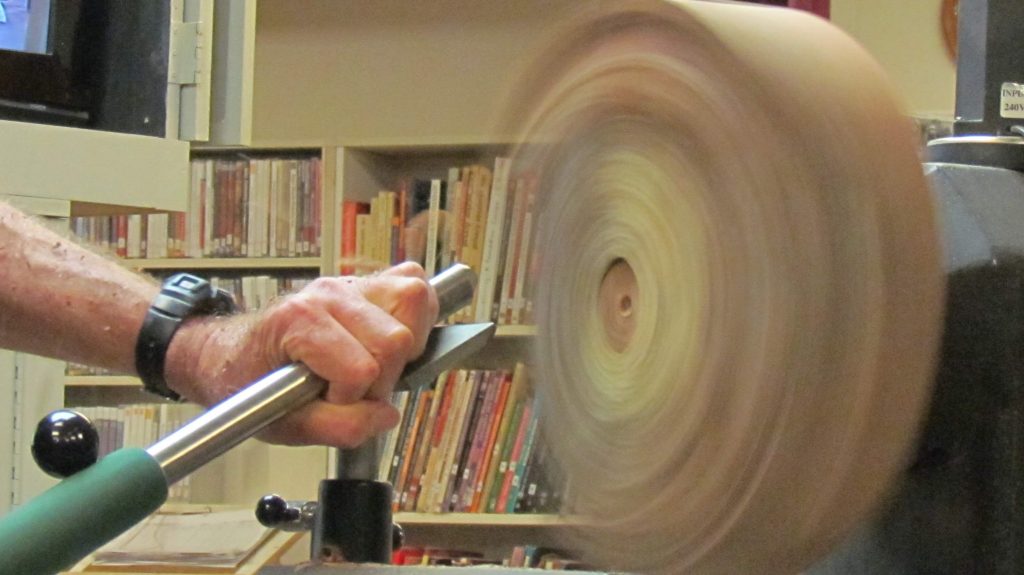
John went on to demonstrate how one would mount and turn a conventional wet half log. He covered briefly how to cut bowl blanks to get different grain patterns within the bowl, butterfly or oval rings etc. John then used a faceplate to attach his large Rewarewa log to the lathe. He prefers to use passivated Tek screws over galvanised, as they are less likely to shear and they come in a great size range.
John then engaged the tailstock for security and to find the live centre. When turning a wet log into a rough cut bowl, a rule of thumb would be to keep a wall thickness of 20-25mm. The base is to be similar, however the spigot will determine this, as an internal spigot or dovetail recess is suggested to allow for remounting options once dried. John reminded us that we would need to guess the amount of distortion with the wood type, to allow enough timber to re-cut both sides of the bowl.
When moving onto the actual cutting process of the wood, John talked about different tool options. Until recently he used a Texas style Hamlet bowl gauge. However when turning rough, out of balance wood, it creates a bad thumping on the bevel. John found to alleviate this irritation somewhat, he uses large Easy Wood tools with carbide tips, tucked underarm for extra leverage and support.
John also recommends using a Chainsaw helmet for this type of turning as it reduces fogging and allows for ear protection. He went on to demonstrate the impressive carbide tools, cutting on centre.
John then let us imagine a scenario where the faceplate had been jammed on to the lathe by the huge amount of torque created when rough turning. While some people use leather washers to alleviate this problem, most do not and they are hard to find.
John showed us his spanner range that he would use to first undo the Tek screws holding the faceplate and remove the wood. He recommends the Gear Spanner from Trade Tools in Ellerslie. Once the wood has been removed, one can then find an appropriate leverage option (in Johns’ case this was a lump of metal acquired from a concrete power pole!) to lever the faceplate from the lathe.
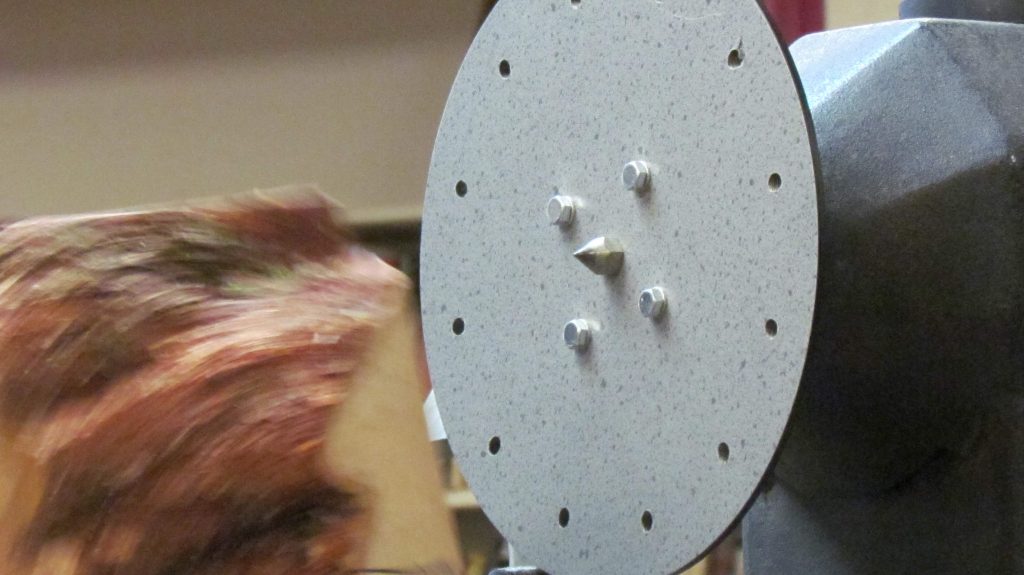
Next John moved on to show us how to mount a rough block, with no practical flat face, to the lathe. His choice of wood was a 10kg uneven lump of Feijoa. He mounted the block between the centres to adjust the balance on the Steb centre. The problem with such a large unruly piece of timber, is that using a Steb or Spur to drive the wood will result in it boring into the green wood. This will also be the case with a screw chuck. The weight of the timber also rules out boring for a small faceplate or expanding jaws.
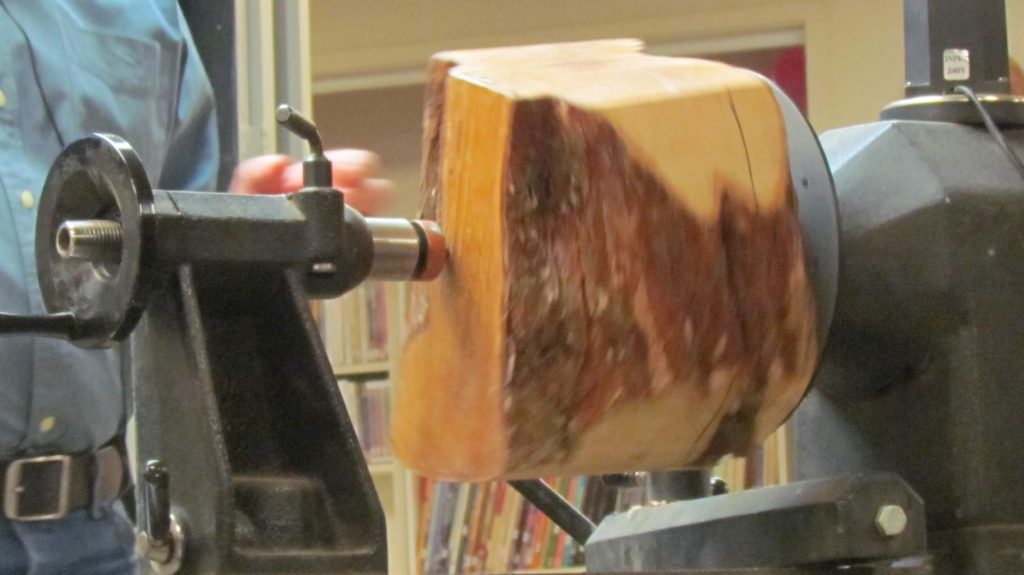
Johns solution to this was to create a large custom faceplate, with multiple holes that direct long screws angularly into the wood. This faceplate was a personal development of an earlier prototype that he passed around, very clever. One could either pilot drill or use a guide to direct the screws in if the wood is hard. John then demonstrated making some cuts, once the faceplate had been mounted. He proved that his mount ran true, as there was no evidence of a wobble in the live centre once the tailstock was removed.
To wrap up the demonstration, John let anyone who was interested in trying out his carbide tools, tackle the Feijoa. An offer that Richard Johnston took up eagerly! A very knowledgeable and interesting demo, thank you John.
Show & Tell 2019-04-10
Dick Veitch – Spinning a Thread
Report by: Janet McDonald
Club Meeting: 3rd April 2019
Dick Veitch gave us a demo on making threaded box lids. After volunteering to write this report I did a double take when he pulled out gadgets and jigs a plenty… but in Dick’s style he soon had everything step by step and slowly everything unfolded in front of us.
There are two main ways of making a thread box thread. One with a hand held tool. The way he showed us was with a setup attached to the lathe bed with a cutter and using a index system. He explained the types of wood suitable for the best results.
I will give the basic outline of what Dick showed us as I am sure this would become a booklet not a report if I detailed everything. Though don’t confuse this with it all being “too hard”, I am sure with practice we could be making threaded jars for our honey dippers in the near future.

Dick used Taraire wood and turned the basic shape of the outside of his box. Then used a forstner bit to take the box centre out. A large wooden jig was placed over the tailstock handle with its own extra large handle, to help keep a more consistent turn of 230r while drilling. A consistent turn helps for a better drilling result. He used Boelue lube on the bit to reduce the squeal.
To prepare for the actual threading, an area of wood was removed from the top outside of the box to allow for the threading depth and for the lid of the box to be threaded over later.
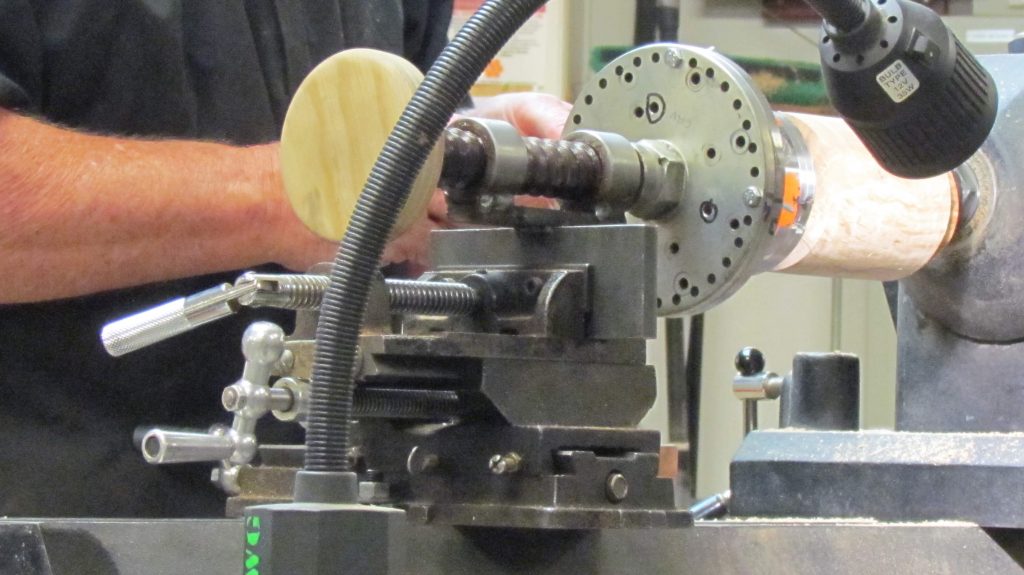
He attached onto the lathe bed the main cutting jig with a thread cutting bit attached to the head stock. The main cutting jig with a 10tpi thread, which the box was attached to, was wound into the headstock to cut the thread into the wood. After a ‘once around cut’ the jig was adjusted using the jigs index plate and another cut made around to add another thread line. The index plate was adjusted 4 times for 4 cuts at 90°. In the end giving a ‘4 Start Thread’.
Then the inside of the lid on the box was prepared and the threading done on it.
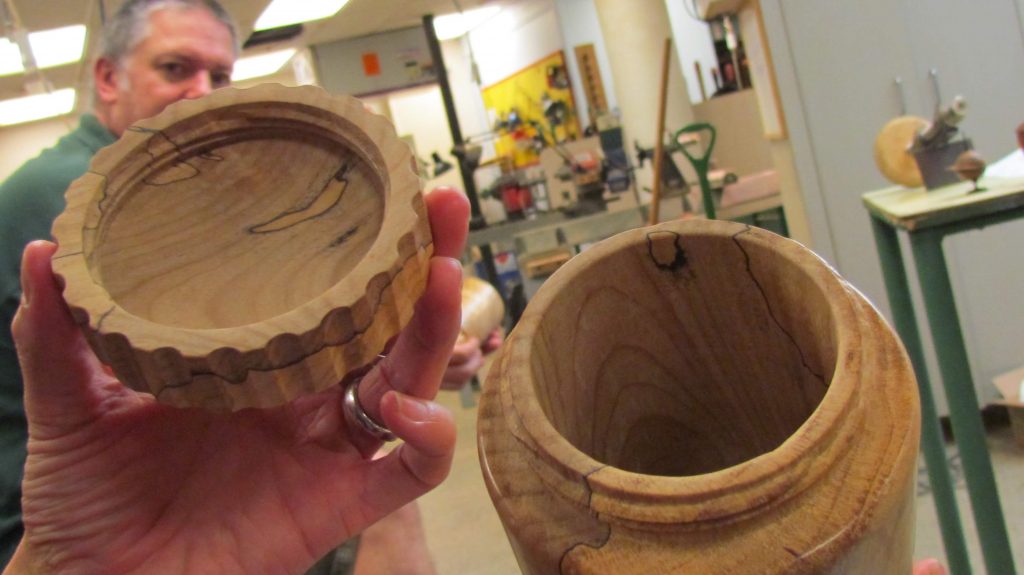
On completion of the threading and the box, Dick with his router made a fluted edge around the edge of the lid to hopefully show people using the box, it was a screw lid and not a pop lid.
